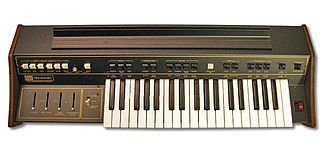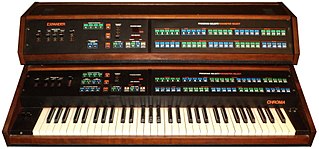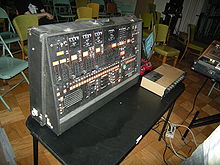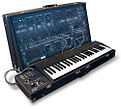
An analogsynthesizer is a synthesizer that uses analog circuits and analog signals to generate sound electronically.

Modular synthesizers are synthesizers composed of separate modules for different functions. The modules can be connected together by the user to create a patch. The outputs from the modules may include audio signals, analog control voltages, or digital signals for logic or timing conditions. Typical modules are voltage-controlled oscillators, voltage-controlled filters, voltage-controlled amplifiers and envelope generators.

ARP Instruments, Inc. was a Lexington, Massachusetts manufacturer of electronic musical instruments, founded by Alan Robert Pearlman in 1969. It created a popular and commercially successful range of synthesizers throughout the 1970s before declaring bankruptcy in 1981. The company earned a reputation for producing excellent sounding, innovative instruments and was granted several patents for the technology it developed.

Behringer is an audio equipment company founded by the Swiss engineer Uli Behringer on 25 January 1989 in Willich, Germany. Behringer produces equipment including synthesizers, mixers, audio interfaces and amplifiers. Though originally a German manufacturer, it now manufactures its products in China. Behringer is owned by Music Tribe, a holding company chaired by Uli Behringer.

The ARP Odyssey is an analog synthesizer introduced by ARP Instruments in 1972.

The Korg MS-20 is a patchable semi-modular monophonic analog synthesizer which Korg released in 1978 and which was in production until 1983. It was part of Korg's MS series of instruments, which also included the single oscillator MS-10, the keyboardless MS-50 module, the SQ-10 sequencer, and the VC-10 Vocoder. Additional devices included the MS-01 Foot Controller, MS-02 Interface, MS-03 Signal Processor, and MS-04 Modulation Pedal.
Arturia is a French electronics company founded in 1999 and based in Grenoble, France. The company designs and manufactures audio interfaces and electronic musical instruments, including software synthesizers, drum machines, analog synthesizers, digital synthesizers, MIDI controllers, sequencers, and mobile apps.

The ARP Pro Soloist was one of the first commercially successful preset synthesizers. Introduced by ARP Instruments, Inc. in 1972, it replaced the similar ARP Soloist (1970–1971) in the company's lineup of portable performance instruments.

The Korg Polysix(PS-6) is a six-voice programmable polyphonic analog synthesizer released by Korg in 1981.
The ARP Little Brother, produced from 1975 to 1977, is a keyboardless monophonic expander module, sold as an add-on for another ARP synthesizer. It was controlled by connecting the control voltage (CV) output of an ARP synthesizer's keyboard to the Little Brother's CV input.

Electronic Music Laboratories, commonly abbreviated to EML, was a synthesizer company founded in 1968 in Vernon, Connecticut, by four engineers. It manufactured and designed a variety of synthesizers sharing the same basic design but configured in different ways.

The Oberheim OB-Xa was the second of Oberheim's OB-series polyphonic analog subtractive synthesizers, replacing the OB-X with updated features.

Korg MS-10 is an analogue synthesizer created by Korg in 1978. Unlike its bigger brother, the Korg MS-20, the MS-10 only has one VCO, one VCF and one envelope generator. It is monophonic and has 32 keys.

A synthesizer is an electronic musical instrument that generates audio signals. Synthesizers typically create sounds by generating waveforms through methods including subtractive synthesis, additive synthesis and frequency modulation synthesis. These sounds may be altered by components such as filters, which cut or boost frequencies; envelopes, which control articulation, or how notes begin and end; and low-frequency oscillators, which modulate parameters such as pitch, volume, or filter characteristics affecting timbre. Synthesizers are typically played with keyboards or controlled by sequencers, software or other instruments and may be synchronized to other equipment via MIDI.

The Sirius is a keyboard "groove-synth," featuring a subtractive hybrid-tone-generation synthesizer referred to as DTE synthesis introduced in 1997 by Quasimidi. The unit featured both real-time and step sequencers with pattern- and song-modes, capable of acting basic drum machine, groove-box, or sound-module.

The Steiner-Parker Synthacon is a monophonic analog synthesizer that was built between 1975 and 1979 by Steiner-Parker, a Salt Lake City-based synthesizer manufacturer. It was introduced as a competitor to other analog synthesizers, like the Minimoog and ARP Odyssey.

The ARP Chroma is a polyphonic, multitimbral, microprocessor controlled, subtractive synthesis analog synthesizer developed in 1979-1980 by ARP Instruments, Inc. just before the company's bankruptcy and collapse in 1981.

The Kronos is a music workstation manufactured by Korg that combines nine different synthesizer sound engines with a sequencer, digital recorder, effects, a color touchscreen display and a keyboard. Korg's latest flagship synthesizer series at the time of its announcement, the Kronos series was announced at the winter NAMM Show in Anaheim, California in January 2011.

The Oberheim OB-1 was a monophonic, programmable, analog synthesizer introduced by Oberheim Electronics in 1978. It originally sold for $1,895 and was the first analog synthesizer capable of storing patches. The design was a replacement for the previous generation of Oberheim SEM based instruments and intended to be used for live performance.























